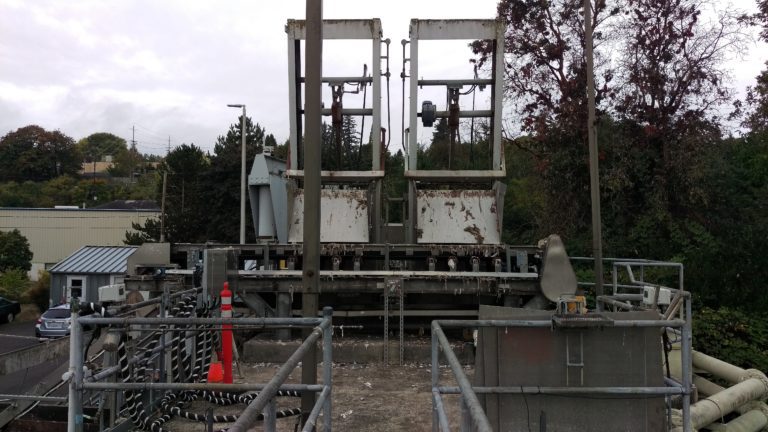SITUATION:
The Tryon Creek Wastewater Treatment Plant is a 38 MGD
activated sludge plant servicing Portland, Oregon and
surrounding areas. The current headworks system at the facility consists of two single rake mechanical bar screens that are nearing the end of their operational lives. They are slated to be replaced during a planned expansion of the headworks to increase capacity to 50 MGD. These screens suffer from reliability concerns, lack provisions for odor control, and are designed at the lower end of the screenings capture ratio (SCR) spectrum, allowing a high percentage of solids to bypass the screen. The system is largely gravity-fed; however, it is considering adding pumps to its system as part of the expansion to a 50 MGD facility. Gravity-fed and pump-fed processes have very different screening requirements.
Equipment: Hammerhead On-site Screen Sizing
Location: Portland, OR
Date: 2017
Consulting Engineering Firm: Black & Veatch

Solids in gravity-fed systems tend to be larger and more intact. Pumps macerate solids, chopping them up into very small pieces, and pass them to downstream processes that requires fine screening to remove them from the wastewater stream. The treatment plant needed optimal screening solutions for each scenario. Tryon Creek Wastewater Treatment Plant worked
with Hydro-Dyne to utilize its On-site Screen Sizing to design headworks solutions for its expansion to a 50 MGD plant utilizing
a gravity-fed or pumped process.
SOLUTION:
Tests were conducted to identify the most effective balance between the protection of downstream processes, expected
equipment maintenance, and capital outlays for both gravity-fed and pumped system scenarios. In all, 46 tests were
conducted.
A variety of screening scenarios were programmed into the On-site Screen Sizing Test, and conducted over the course of
several days and times to thoroughly understand how periods of peak flow would be managed under multiple conditions.
On-site Screen Sizing Tests revealed that the current 5/8-inch mechanical bar screens could only operate at 20-30%
Screenings Capture Ratio (SCR).
RESULTS:
Data analysis from Hydro-Dyne’s On-site Screen Sizing very clearly revealed different screen size solutions for the two plant
expansion scenarios. If the plant chose to utilize centrifugal pumps, a screen with a 5mm perforated plate grid and variable
frequency drive was proven to increase screenings capture by 70% over current equipment, for a total SCR of as much
as 90%. This equipment design would also enable the screens to accommodate instantaneous large solids loading that
could occur. If the plant chose to remain a largely gravity-fed system, H.O.S.S. proved that a screen utilizing a 6mm slotted
(laced link) screening element would allow organic material to more freely pass through the system, sufficiently protect
sensitive downstream processes, and reduce the need for more sophisticated screenings washing. The intelligence and
recommendations provided by On-site Screen Sizing allowed the utility to make better informed decisions in the upgrade
of the plant to a 50 MGD system.